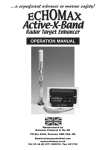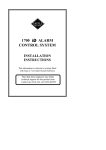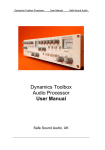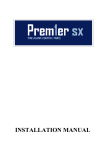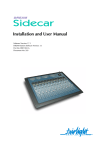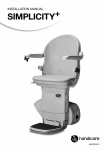Download Electro-Dan SS20202014 User manual
Transcript
Electro-Dan SS20202014 Surround Sound Amplifier User Manual Introduction The Electro-Dan SS20202014 (SS Triple-20, 14) is a complete Surround Sound Preamplifier, decoder and Power Amplifier all in one box. A stereo input, mains input and a further 4 or 5 speakers is all that is needed to complete a home cinema system. Features: • • • • • • • • • • • 20W per channel RMS* power to front left and right channels. 20W RMS* power to rear channel. 14W RMS* power to centre channel. Pre-amp with loudness filter and tone controls. Matrix surround sound decoder with centre channel output. Level controls for front, rear and centre channels. Power switches for rear and centre channel amplifiers. Headphone output and switch. Inputs for external decoders** (i.e. 5.1 Dolby® Surround Sound). Centre and Subwoofer pre-outs. Temperature Controlled cooling Fan * RMS power refers to the true power of an amplifier, it is obtained by the RMS voltage and RMS current at the output. ** The rear pre-in is only Mono (1 channel). A stereo input is provided, but the unit will convert this to mono internally. Page 2 of 11 Operating the system The SS20202014 has mains input and output sockets. These are in the form of European style 3-pin connectors. WARNING: These connectors carry mains voltage of 230-250V AC and it will kill you if care and consideration is not taken! ATTENTION: The units input must be properly Earthed (Grounded), failure to do so may result in electric shock! Wires used in the 3-pin connector: Brown: Blue: Green/Yellow: Live Neutral Earth This unit must also be fused with a 3 Amp (Red) fuse rated at 250V AC. Mains Outlet There is a mains outlet socket. This can be used for switching an external appliance. The appliance must have the appropriate plug and must not have a current greater than 2 amps absolute maximum (This is about 500 Watts). Remember that the appliance will only be able to operate when the Surround Amplifier Unit is switched ON. If in doubt, plug the appliance into a house mains socket (or rated trailing socket). Fuses In the event of a failure, two fuses are used to protect the unit from damage. Observe the ratings of these fuses. These should be T0.4A (Time delay glass fuse rated at 250V AC) and F0.2A (Quickblow glass fuse rated at 250V AC). Page 3 of 11 Safety Precautions The SS20202014 is like many other electrical units and safety must be assessed for safe and reliable use. • NEVER REMOVE THE COVER OFF THIS UNIT – MAINS VOLTAGES ARE INSIDE! DO NOT MODIFY! • IF QUALIFIED FOR SERVICE, REMOVE THE MAINS PLUG FIRST BEFORE OPENING THE COVER! • KEEP THE UNIT WELL AWAY FROM MOISTURE AND HUMID AREAS! • DO NOT USE THE UNIT OUTSIDE AND KEEP IT AWAY FROM DIRECT SUNLIGHT! • • DO NOT SUBJECT THE UNIT TO SHOCK! ALWAYS EARTH THE APPLIANCE WITH A SUITABLE, MAINS RATED EARTH CONNECTION! • DO NOT STORE THE UNIT IN A VERY LIMITED SPACE – IT MUST BE ABLE TO ‘BREATH’ AND NOTHING SHOULD BLOCK THE FAN INLET! • DO NOT SPILL LIQUID ON THE UNIT! • KEEP THE UNIT AWAY FROM AREAS OF HIGH DUST! • DO NOT USE NEAR OPEN OR NAKED FLAMES! • IF PROBLEMS EXIST, TRY KEEPING THE UNIT AWAY FROM MAGNETIC FIELDS (i.e. loudspeakers) AND RF EQUIPMENT (i.e. TV’s and radios)! Page 4 of 11 • DO NOT POKE THE UNIT WITH SHARP OR THIN OBJECTS! Hooking Up the SS20202014 The unit is designed to decode a stereo signal, usually from a TV, VCR or similar appliance. It will also accept signals from Hi-fi equipment (i.e. CD players) or even personal stereos. A Mono input can only be used once it is split into two channels by a splitter. Note that rear surround sound does not work with mono inputs. If your TV or VCR does not have Phono line outputs but does have a spare SCART socket, then special adapters can be used to convert the SCART socket to three phono plugs (Video, audio left and audio right). The audio left and right (coloured white and red respectively is what this unit requires). Left is a rear diagram for the amplifier unit: If you own a DVD player, separate decoder or home computer that has analogue outputs for surround sound, then this unit can use them Page 5 of 11 to improve the decoding of the surround sound. On some DVD players there are line outputs for surround sound (usually Dolby® Digital 5.1 Surround Sound). Using the correct lead, these outputs can be plugged into the preinputs of the SS20202014. For the rear channel, a lead with two phono sockets to a 3.5mm stereo jack socket is required, shown left: For the centre channel, a similar lead is required but it only has to be mono and therefore may have one phono socket and a mono 3.5mm Jack Plug. Some multimedia personal computers now come with quad or 5.1® outputs. These can also be used, However the leads are more likely to be jack-to-jack plugs. Note that when you push in and pre-in jack plug, the internal decoding is disabled, but you can still use the level controls on the front for adjustments. The volume controls will not however adjust the volume of rear and centre pre-ins. Setting up your speakers Now that you have plugged in the mains and inputs, you now have to set-up the speakers. The optimum surround sound uses two front speakers, correctly wired up for left and right audio, a centre speaker which is placed in the middle of the two front speakers and a two rear speakers which Page 6 of 11 are placed behind the listening position. The diagram below shows the layout. To ensure the long term reliability of your surround amplifier, certain criteria needs to be looked at for loudspeaker selection. The table below looks at the impedance of the loudspeakers on each channel. Channel Impedance Front Right 4 ohms to 16 ohms (Min/Max) Front Left 4 ohms to 16 ohms (Min/Max) Rear Left 8 ohms to 16 ohms (Min/Max) Rear Right 8 ohms to 16 ohms (Min/Max) Single Rear 4 ohms to 16 ohms (Min/Max) Centre 4 ohms to 16 ohms (Min/Max) Note: The table includes data for a single rear channel. The rear may be set up with just one speaker (plugged in either the left or right outputs, not both), which can be placed directly behind the listening position. This effect is not as good as twin rear speakers, but it does allow a 4-ohm speaker to be used. Front speakers should be rated at 20W each or more, rear speakers (twin) should be rated at 10W each unless there is a single rear Page 7 of 11 which should be 20W minimum. The centre speaker should be rated at 15W minimum. For best results, use speakers that are matched for best sensitivity. Cable used should be capable of passing the required power. Thicker, higher quality cable will give better results. Warning: The centre speaker and the front speakers must be magnetically shielded if they are placed near a Television. If this is not observed, the cathode ray tube inside the TV will suffer. Listening to the SS20202014 When you first listen to you surround sound amplifier; you need to adjust it to the settings you prefer. Connect it up to you TV, VCR etc. and find a good movie! More recent movies have the best surround sound coding and these should be used. If you are using the internal decoder, you may adjust the volume, bass, treble and use the loudness to suit your needs on all channels. A good test movie should make use of all frequencies so you can adjust the bass and treble to the best possible preference. The loudness can be used to increase the high and low frequencies slightly when listening at low volumes. You will notice that when there is speaking, sound only comes from the front and centre channels. When there is action or music in the movie, there should be sound from the rear channel. If this is not so, make sure you are feeding the unit with a stereo signal (i.e. NICAM® or that the movie is not old (and therefore only mono). Modern music is also stereo and this surround sound unit can add another dimension to many types of music from rock, pop to recent classic. Page 8 of 11 When listening, the centre speaker should be adjusted to the point where you can ‘just’ hear it. This is the optimum setting for many movies and music. Too loud and you will not get the stereo front image and also overload the centre amplifier or speaker much easier when the volume is turned up. Turning off the rear and centre amplifiers When listening to music (for instance), you may not want the rear or centre channels (or both). Two toggle switches on the front of the unit allow you to disable the amplifiers for the rear and centre channels, and hence remove the sound. You may want to also disable the rear channel if you are listening to mono sound (which saves power and improves the life of the rear amp). Private listening A pair of headphones can be plugged into the 6.35mm jack at the front of the unit. To use the headphones, press the headphone selector switch (next to the jack socket) and the sound to the front is cut and passed to the headphones instead. Note that although the power is cut when headphones are used, the output of this unit is still sufficient enough to destroy most headphones when the volume is turned up, so keep the volume low at all times, especially when switching to the headphones from normal listening. When switching to headphones, the front left and right is cut, but the centre and rear channels remain active. To disable these, use the toggle switches as described above. When all channels are disabled, you may listen privately! Page 9 of 11 Troubleshooting • The unit has no sound and the LED indicator is not lit. Did you press the power switch? Check the power, is it connected? If so, check the fuses in the mains plug and the unit and replace any that have blown. • The unit has no sound, but the LED indicator is clearly lit. Check the volume, is the main volume sufficient? Check the individual channel levels, are they sufficiently turned up? Is the headphone switch pressed in and the rear and centre power switches switched up. If all is true, check the inputs. Is the source on and working and is the input lead securely connected? • The sound is distorted. Reduce the volume on the main unit or on the source. • One (or more) of my speakers is not working. Check the connections to the speaker(s) and the surround amplifier unit. Are they secure and are they properly connected (+ and -)? Check the speaker(s) with another amp to see if it is blown. • The sound cuts out. The unit is too hot, turn it off. If problems persist, consult dealer or manufacturer. • The fan does not spin. The fan only spins when the unit gets hotter. • I’ve just be killed by the unit You did NOT properly EARTH the unit, make sure it is properly earthed in your next life! Page 10 of 11










